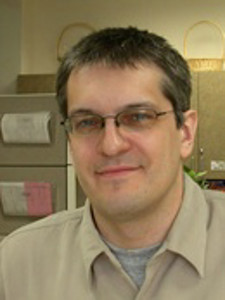OSE Seminar by Distinguished Professor Pavel Lushnikov on Self-focusing and collapses of laser beams in nonlinear optical media
Departmental News

Posted: January 29, 2025
Date: Thursday, February 6, 2025
Time: 12:45 PM to 1:45 PM
Location:PAIS, Room 2540
Speaker: Distinguished Professor of Mathematics Pavel Lushnikov
Abstract:
Powerful laser beams propagating in transparent optical media modify the media index of refraction. In many generic materials like fused silica the index of refraction increases with the laser intensity forming the effective focusing lens which is called self-focusing. Above a critical power, self-focusing turns catastrophic focusing power at finite laser propagation distances to a small area and eventually causing optical damage with formation of plasma as was routinely observe in experiment since advent of lasers. Such catastrophic self-focusing if often called by the collapse of the laser beam. We review a derivation of nonlinear Schrodinger equation (NLSE) in nonlinear Kerr media which allows to develop a theoretical description of collapse and identify the critical power. Media with small quadratic nonlinearity beyond Kerr nonlinearity result in modification of NLSE to Dawey-Stewartson equation by adding nonlocal effective nonlinearity which also admits both critical power and collapse. We develop theory of collapse events and consider various applications to multiple filamentation of laser beam, laser fusion and nonlinear beam combining.
Biography:
Distinguished Professor Pavel Lushnikov is a mathematician who works at the boundaries of applied mathematics and theoretical physics. His research encompasses various fields including fluids, optics, plasmas and mathematical biology.
His contributions have been extensive, spanning topics including the interactions between lasers and plasmas, the dynamics of fluids that involve free surfaces studying phenomena such as wave collapse, Bose-Einstein condensation of dipolar gases, pattern formation in photo-refractive crystals, and the mathematics of aggregation and collapse of bacterial colonies. One of his notable achievements is a solo-authored article titled “Structure and Location of Branch Points for Stokes Wave on Deep Water.” This publication reportedly solved a long-standing problem of 130 years and has been celebrated as a remarkable breakthrough in the field.
Lushnikov has a substantial publication record including 61 articles in peer-reviewed journals, one book chapter and 15 conference proceedings and other publications. He holds a prestigious position as a lifetime Professor at the Russian Academy of Science and was granted a Doctor of Science degree from Landau Institute of Theoretical Physics in Moscow in recognition of his achievements.
